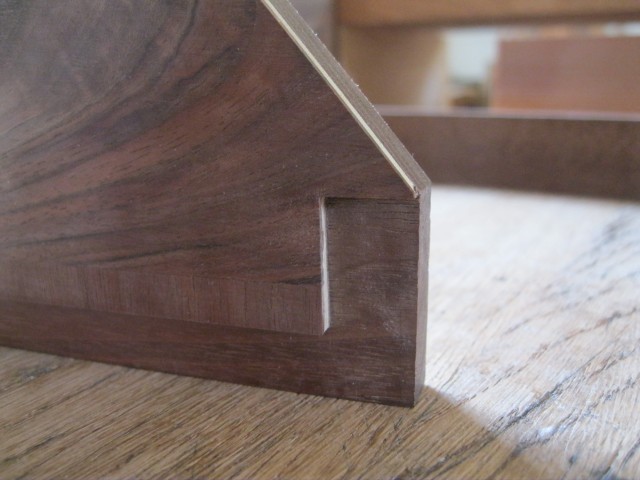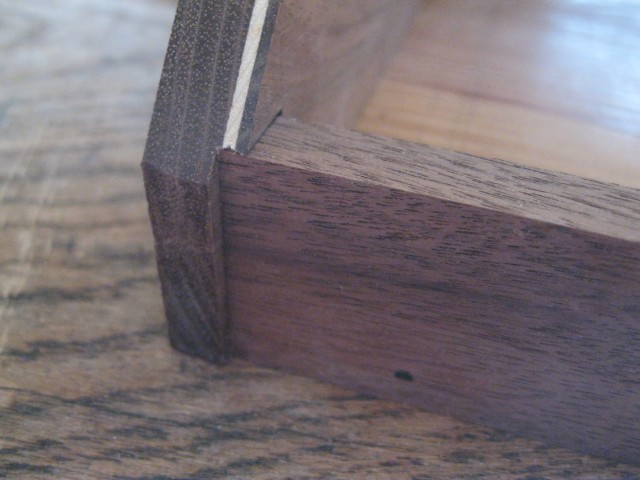Hello, everyone:
The front rail and left cheek of the spinet are on.
Thus begins the assembly of the outer case walls. Further inside support bracing will follow, once the walls are up.
The front rail is a single walnut strip glued and nailed to the edge of the pine baseboard. The ends were left proud and then cut flush with the left and right baseboard edges. That was the easy part, compared to what came next.
I had decided to lap the front edge of the cheek over the rail’s end. It is a common approach in old spinet joinery since it limits exposed end grain and gives a cleaner look. Doing so added a complication.
The cheek has walnut crotch veneer on its inner face (the one toward the keyboard area). The solid walnut core had to butt against the baseboard and rail end directly, so I had to cut away the necessary portions of veneer to bring the contact surfaces together, as shown here (the picture is of the right cheek, still unattached as yet, but treated the same as the one now attached).
While this may appear cumbersome (and it was!), I felt it was better to veneer most of the cheek surface to guarantee solid adhesion, then mark directly from the front assembly the portion needing removal and off I went trimming away. The edge of the remaining veneer would overlap the top of the rail, as here:
The cheek also fit into a vertical dado cut into the beech wrest plank and its support block, also a period spinet joint. The end grain of the baseboard and rail was sized with thinned hide glue. After a short interval to let the sizing set, fresh glue went on all contact surfaces (thanks, Bill, for your assistance). The cheek slid down the dado, into position. Two small nails secured it to the baseboard and rail.
I left the front edge of the cheek proud, later to be cut back flush with the rail’s face.
You may have noticed a very slight gap between the overlapped veneer and the top of the rail. It will be covered by thick crossbanded cap veneers glued to the rail top and butting against the cheek. The top edge of the cheek will also receive cap veneers. The gap on the inside, behind the rail, is of no concern. It will be unseen since the keyboard assembly will mask it, so there was no reason to fuss that fit.
Next up: the long spine along the spinet’s back and the left curved panel that will butt the cheek and lap over the spine.
More glue and nails coming!
Ed









Nice work Ed. How was the curve on the left piece achieved? Was it cut or bent?
Jim
Hi Jim, the piece was boiled and bent. The character of the curves vary a lot across the old instruments, from graceful to barely a curve at all. Mine is okay, but not the best.
Thanks for the comment. Ed
Nice work. Just curious about the design. Why use the nice crotch veneer only on the inside of thoses side peices and not on the outside surface.
Hi Matt, great question here. The early English spinets usually used plain walnut for the solid cases, for workability and color, since walnut still predominated the spinet and furniture practice then (1710s- 40s). As a contrast, though, they would lavish beautiful wood as veneer just in the keyboard area. It really sets off that part of the casing in a very noticeable way. Later instruments (1750s-80s) expanded the veneer work across the entire exterior case surfaces, usually as panels with crossbanding around them. Part of the change was the introduction of mahogany into the practice. Since mahogany does not lend itself to bending, the curved parts were usually made of oak (very bendable) and mahogany veneer gave the final look. So it is all partly based on certain looks at certain times, as well as the working properties of walnut vs. mahogany. Hope this helps. Thanks for the comment.
Ed
Thank you for this fantastic site, and for the work you do.
Just curious: will you be using bone or ivory for the keyboard, and will you do black naturals or black sharps? (Ebony, I assume? Or a dark fruit wood?) Also, iron music wire is available in addition to modern steel – will you be tuning to authentic pitch with iron wire?
Thanks again – Ryan
Hi Ryan: For this instrument, bone naturals, ebony sharps. By the early 18th century, English instruments had already begun moving to this arrangement, while much of the Continent continued with the “reverse” scheme for a while longer. Marc Hansen and I used stained pearwood with ebony caps for the sharps in the past as well (there is historical precedent for that, too). To your second question, iron and brass stringing to A415 has been our standard practice. The early scale of my model here leans in the direction of an all-brass stringing, which will be new to me but certainly not to others. George Wilson and Marc Hansen made a Stephen Keene copy years ago which was all brass. Haven’t done it since. Time to do so, if this works. Thanks for the comments. Ed.
Did you ever read the John Barnes book on Spinet making, and, if so, did you find it helpful?
Yes, we have a copy of Barnes’s book here, and yes, it is worthwhile when focusing on early 18th century English spinets. Less applicable to the later designs.
It’s a good place to start, especially in using evidence from an old spinet as the basis for deducing possible period work procedures. I’m not sure if the plans he refers to in the text are still available. Ed.
Thank you.